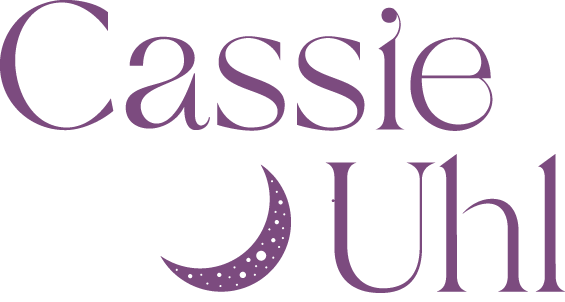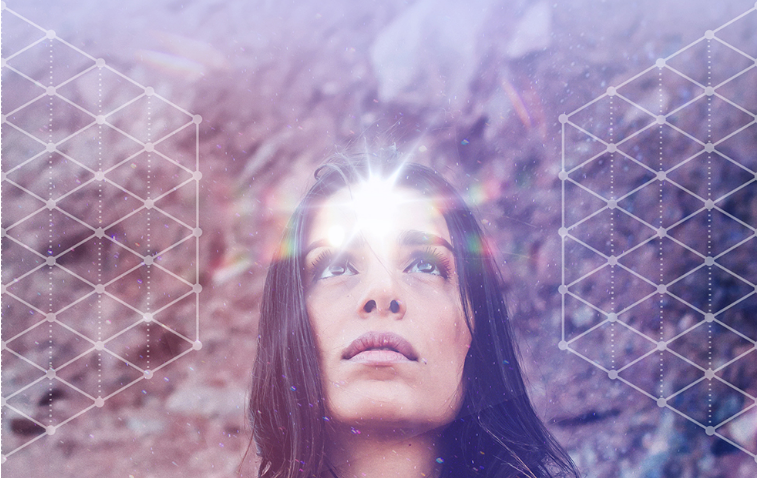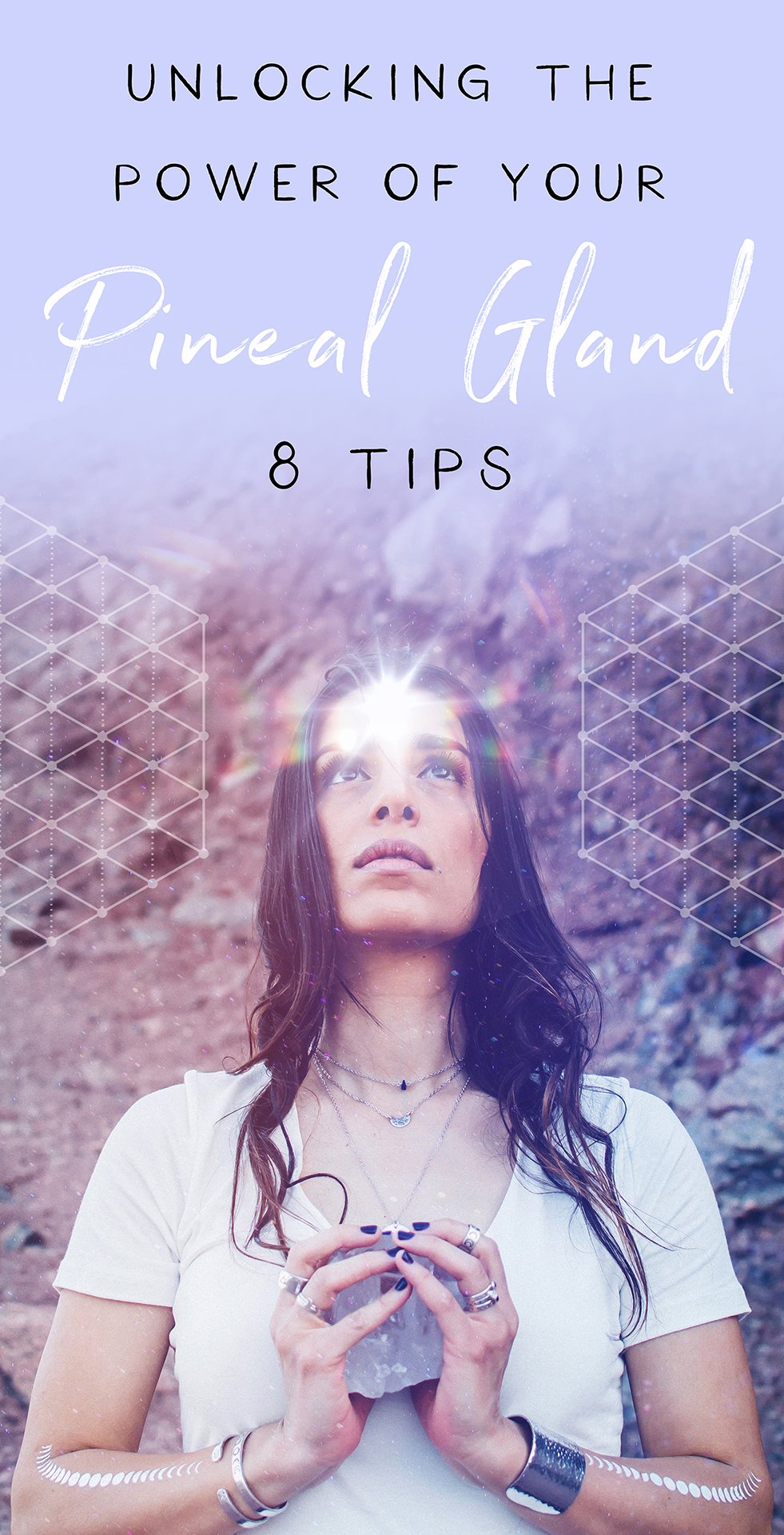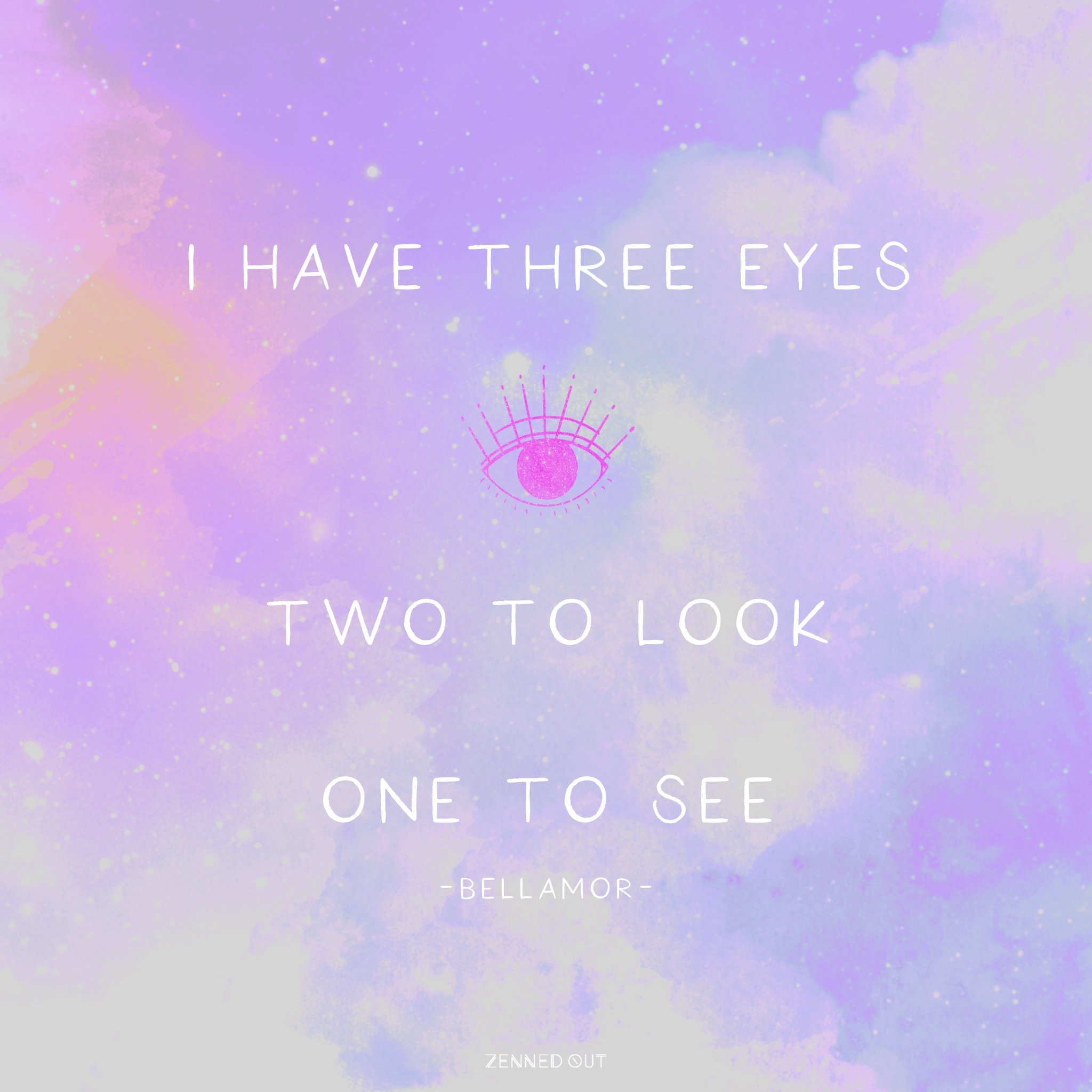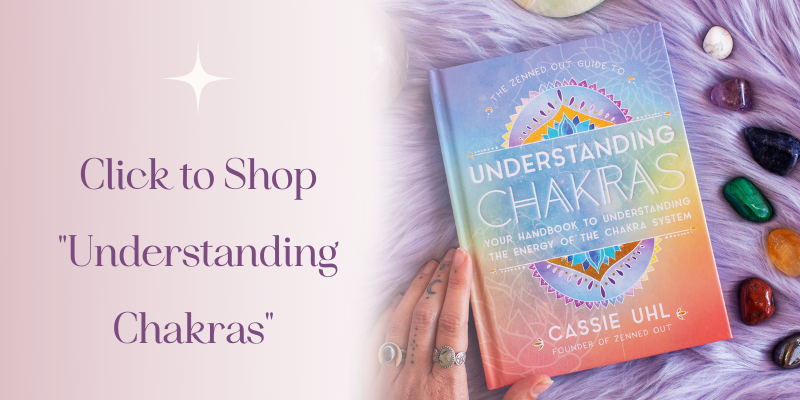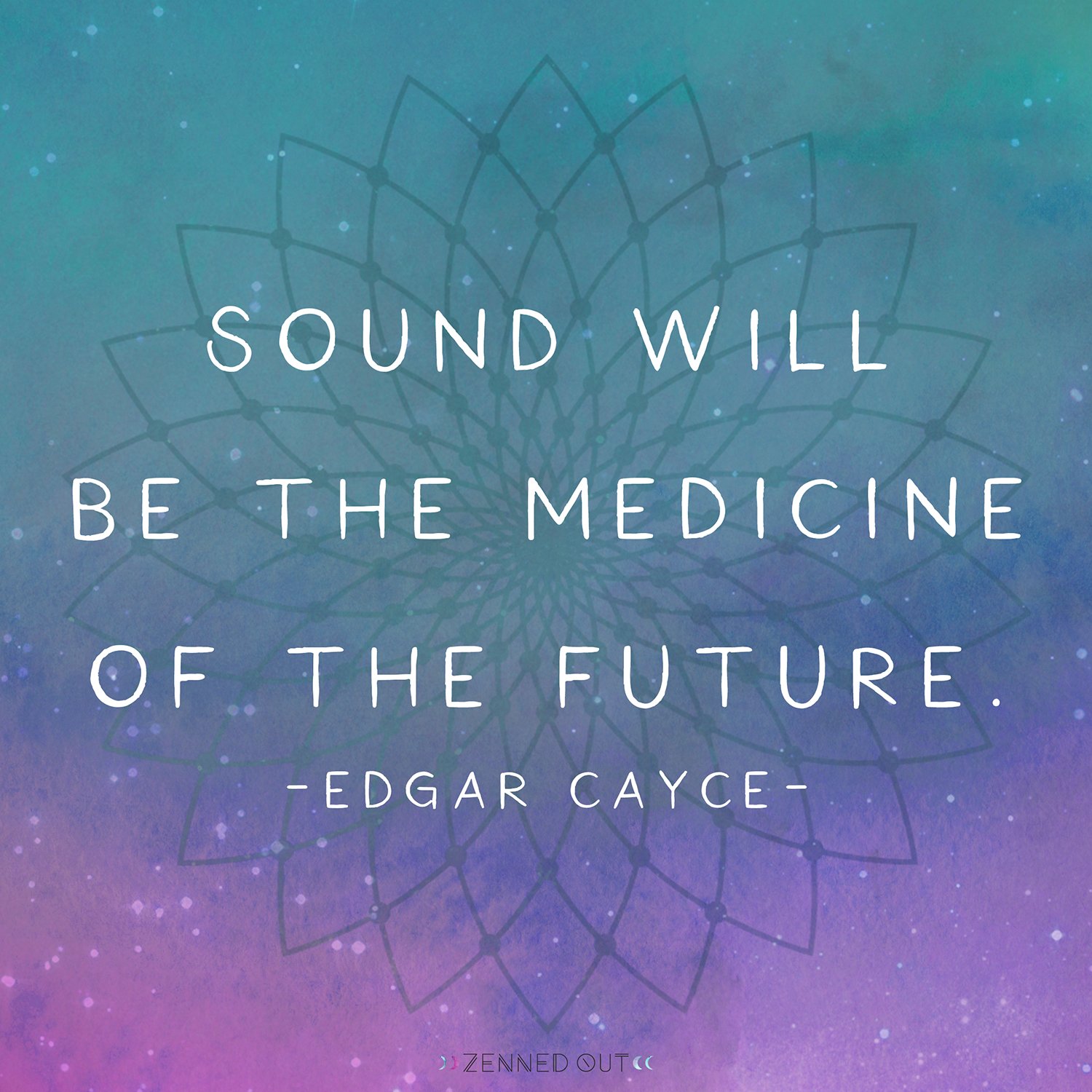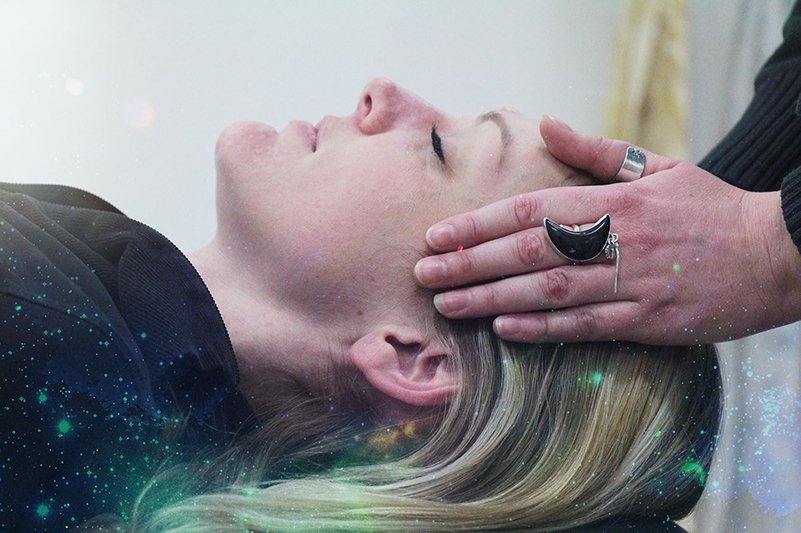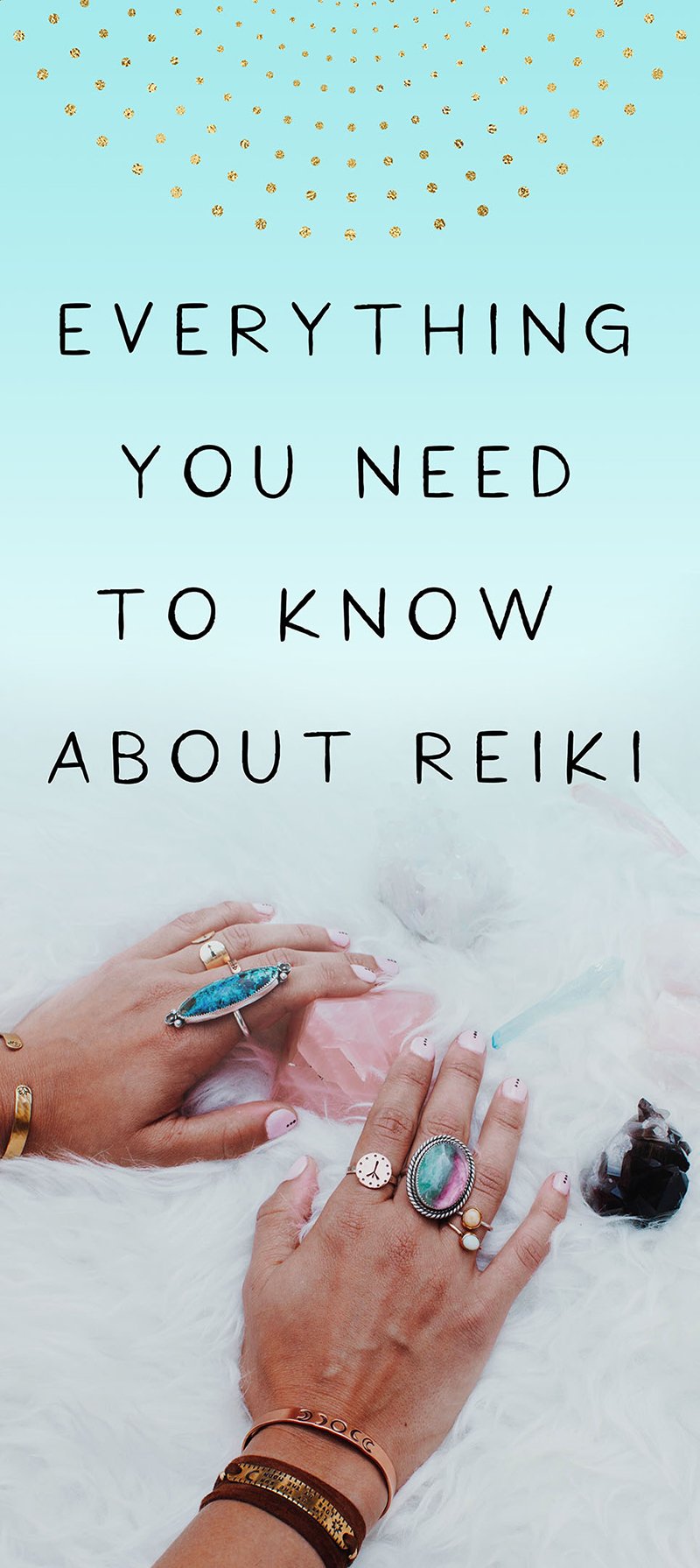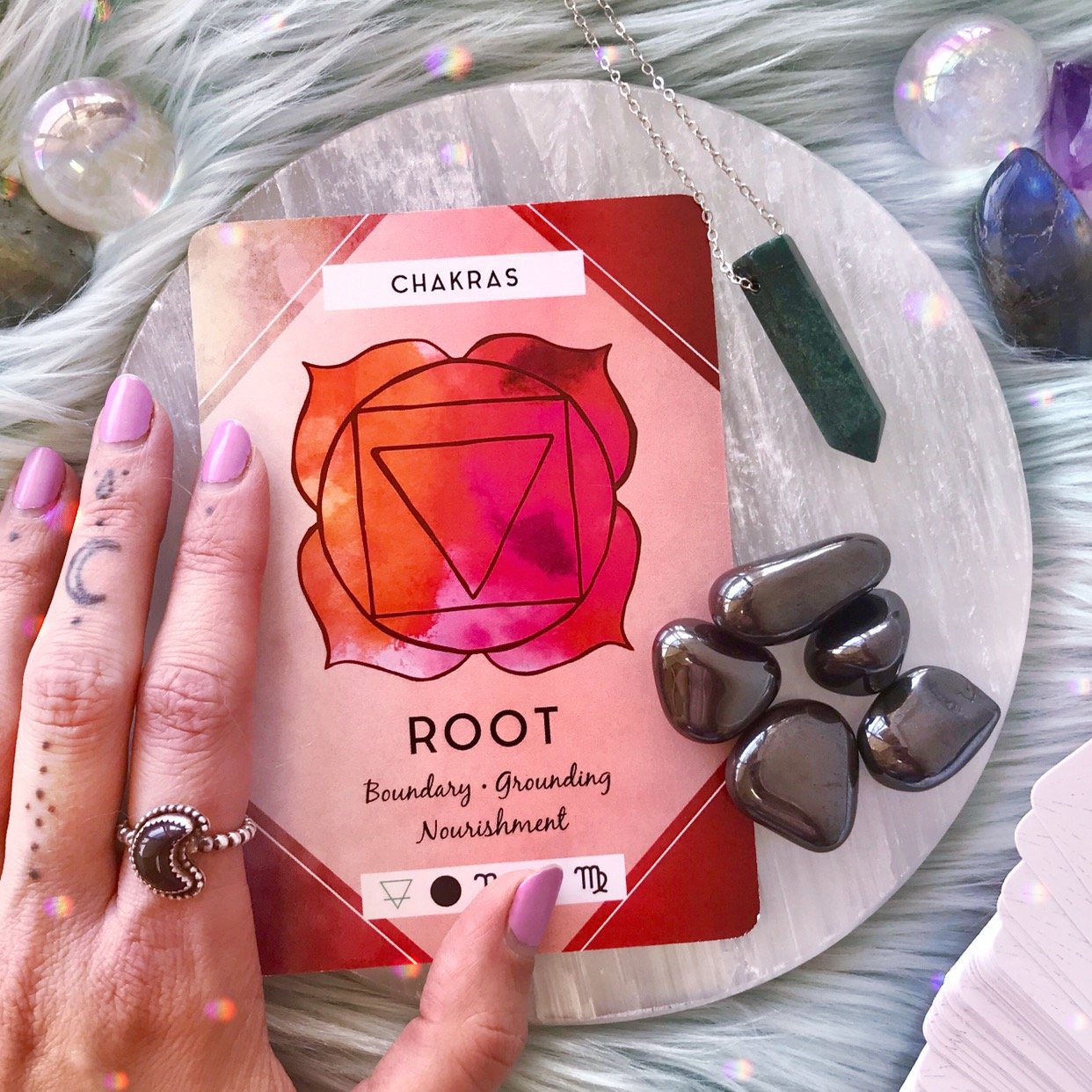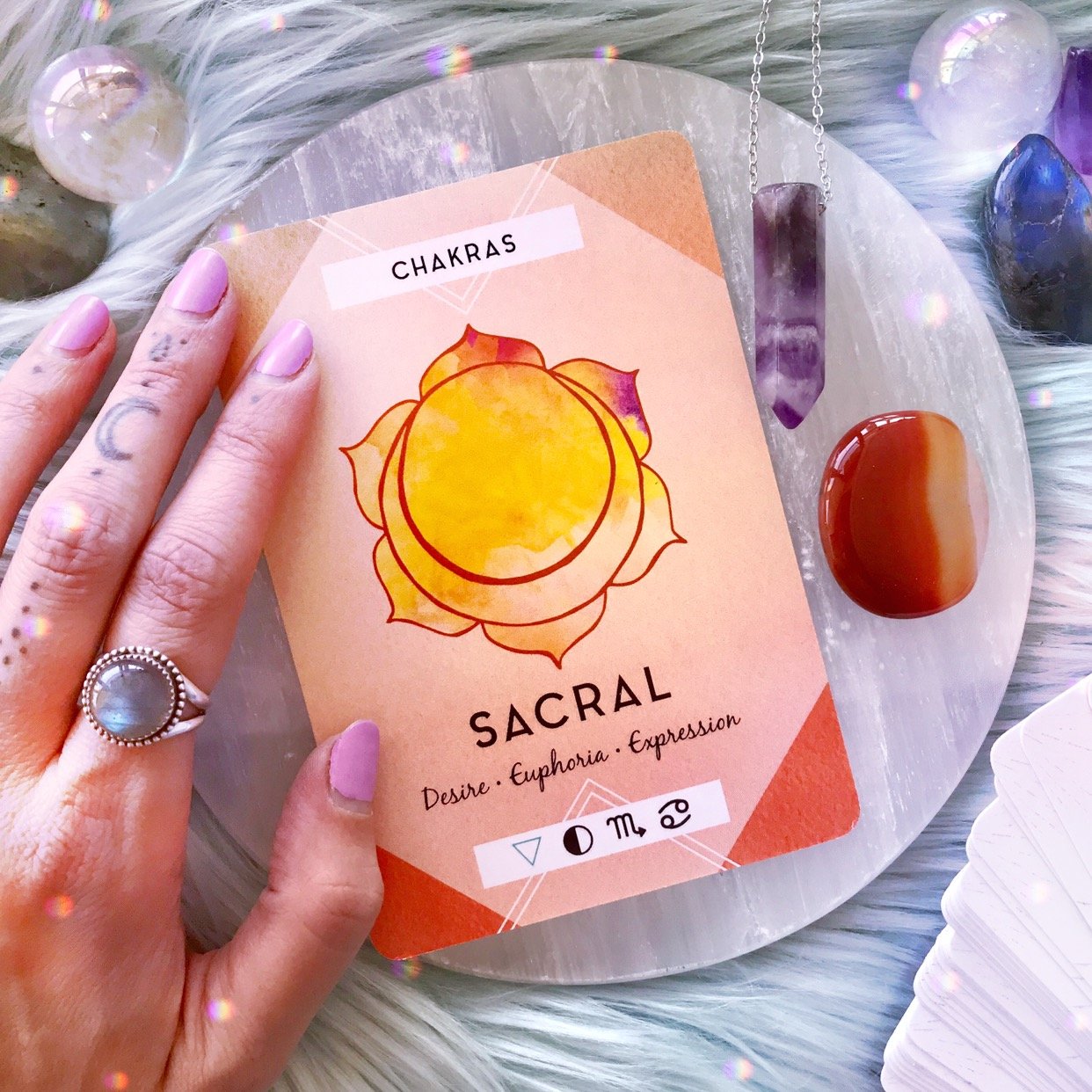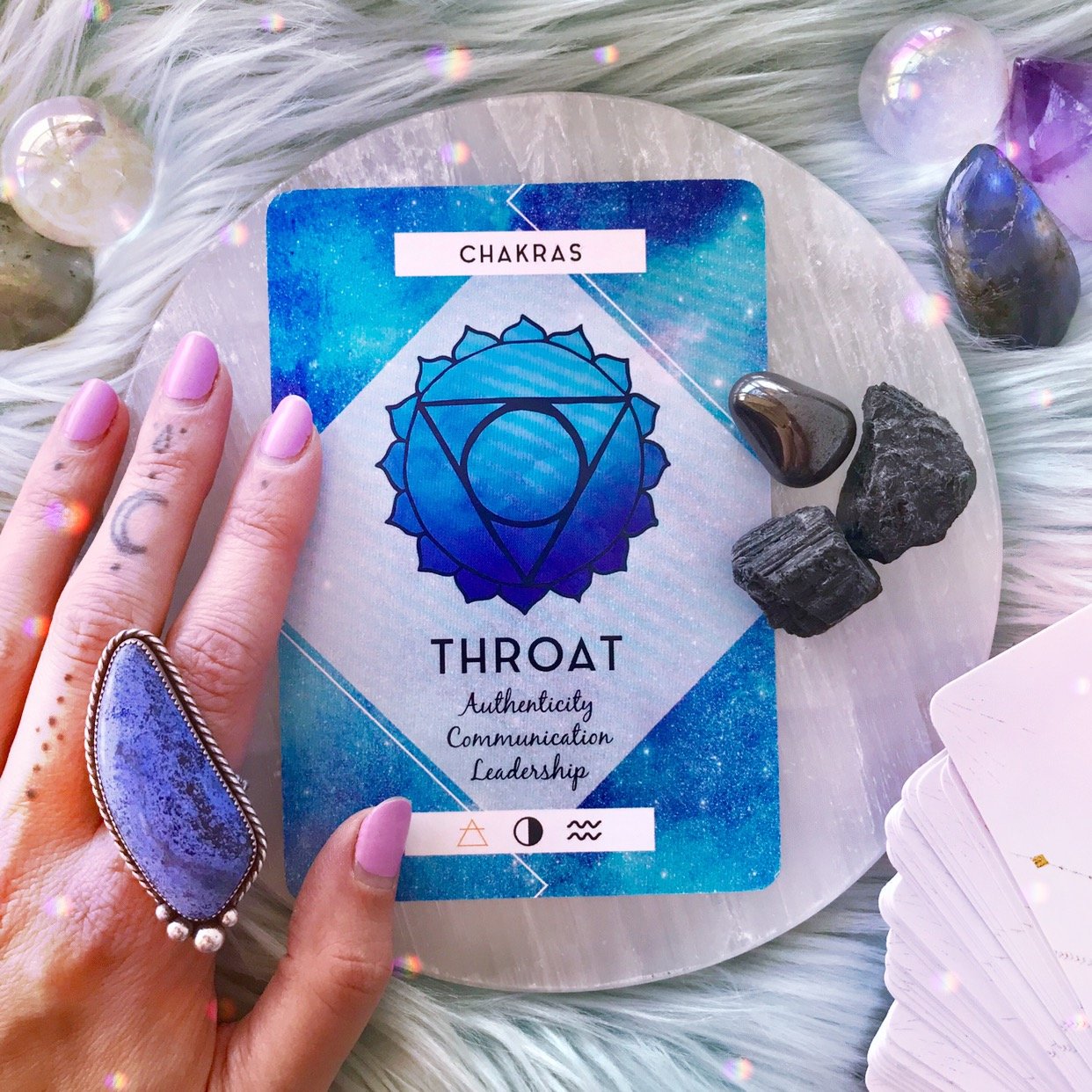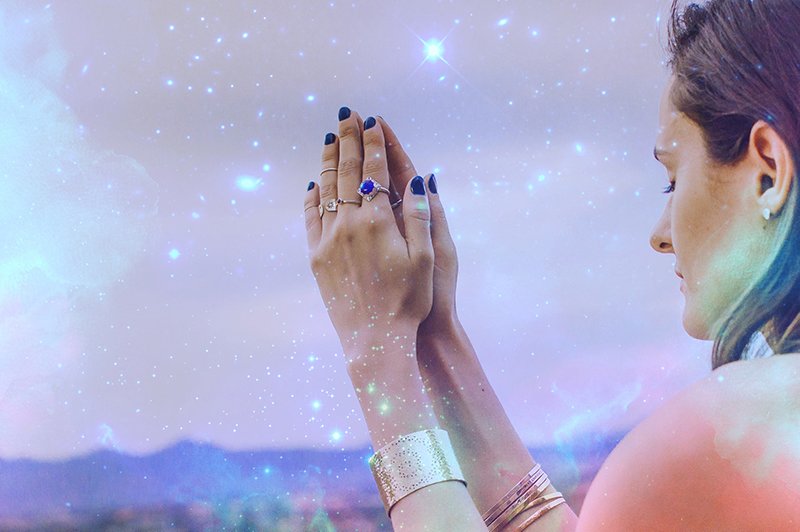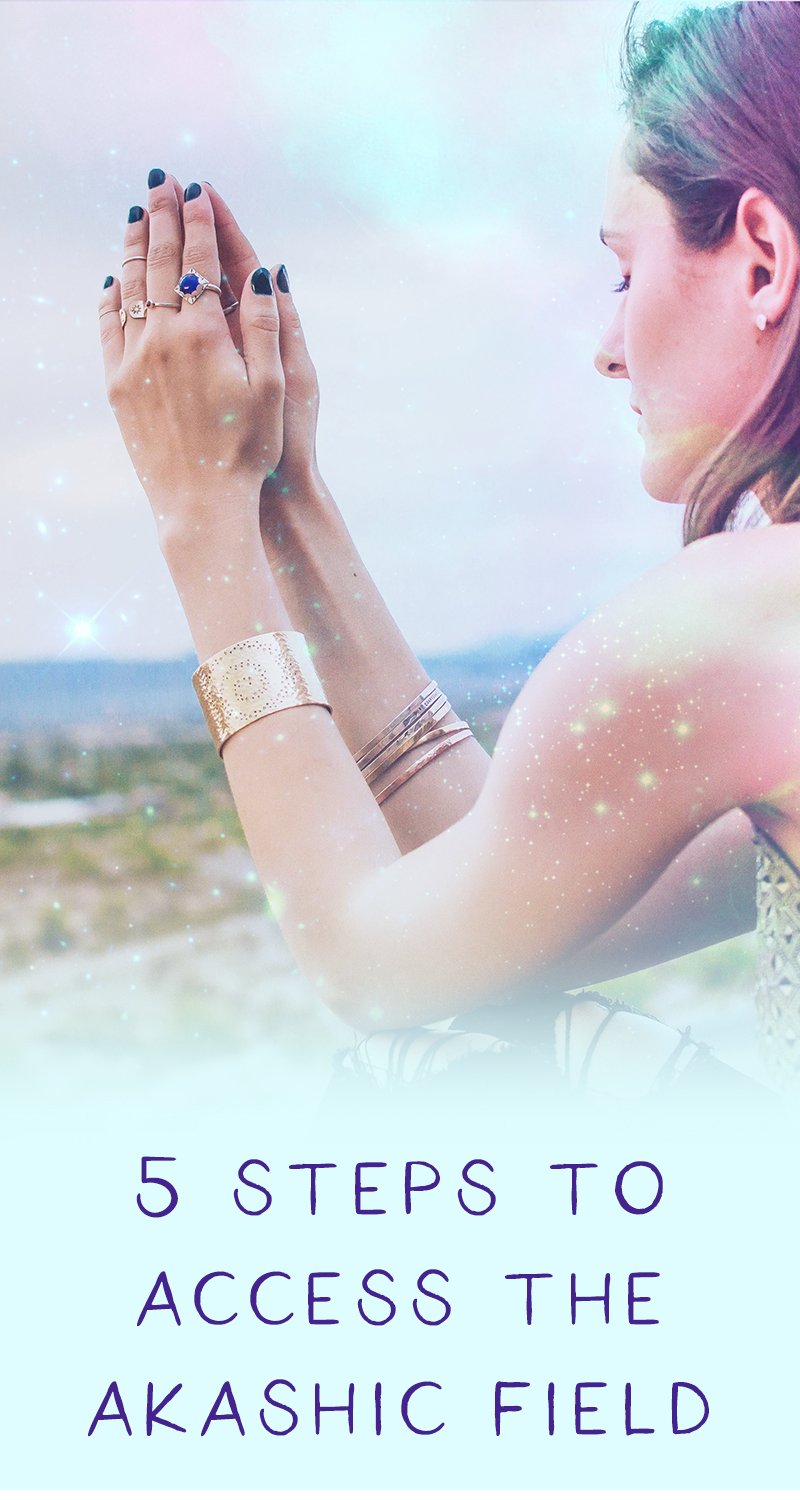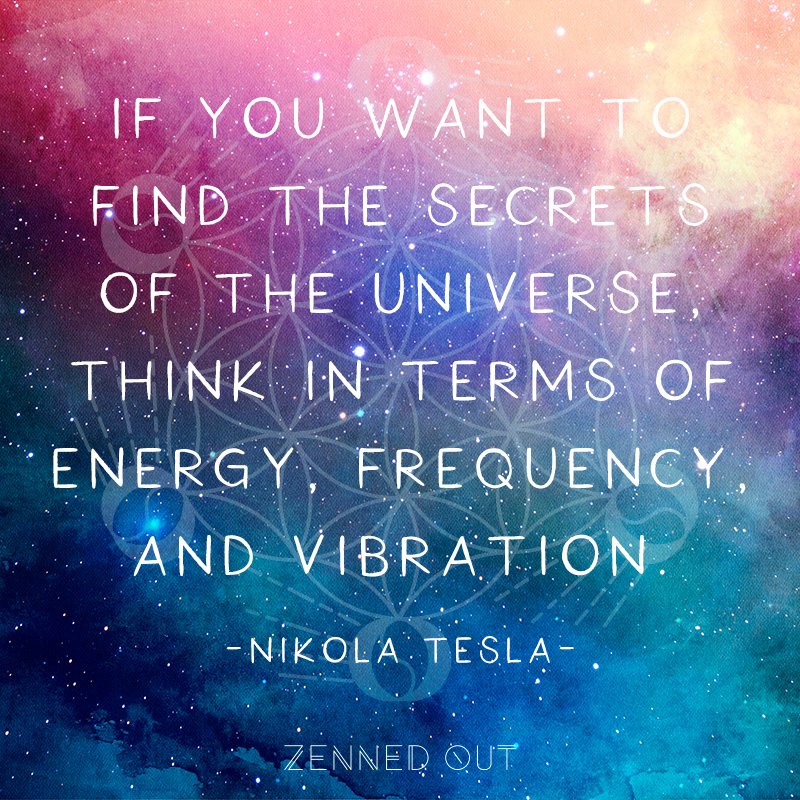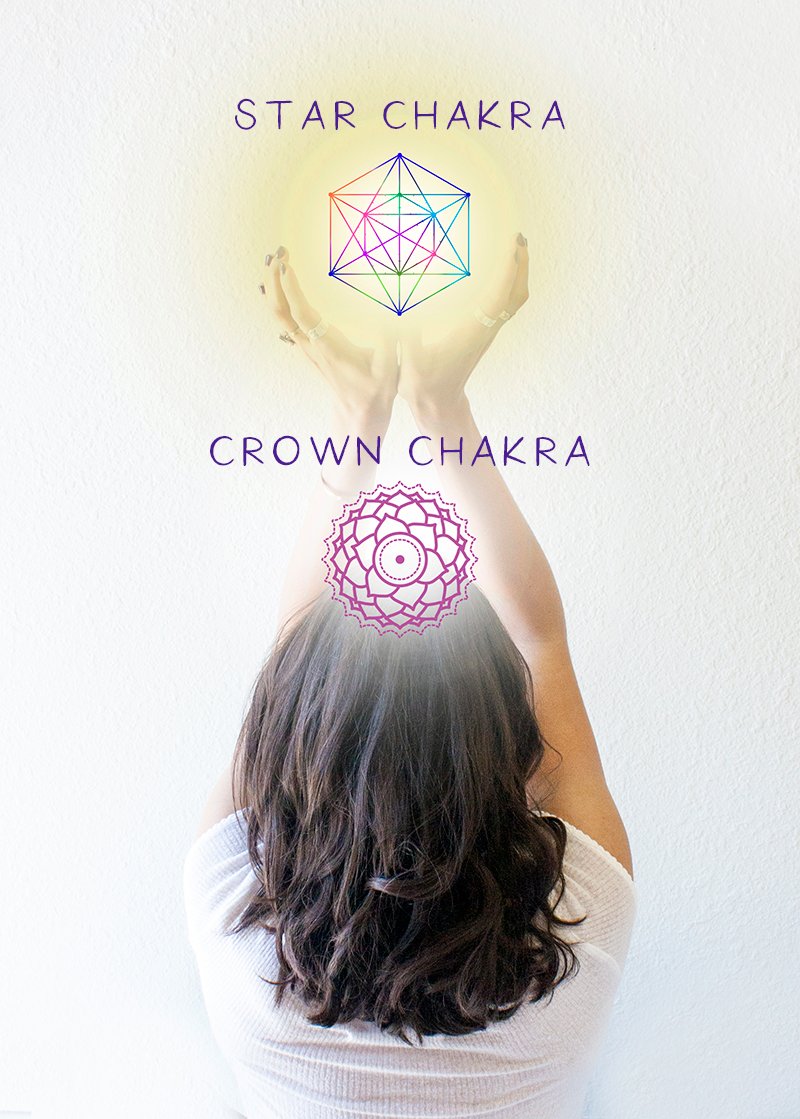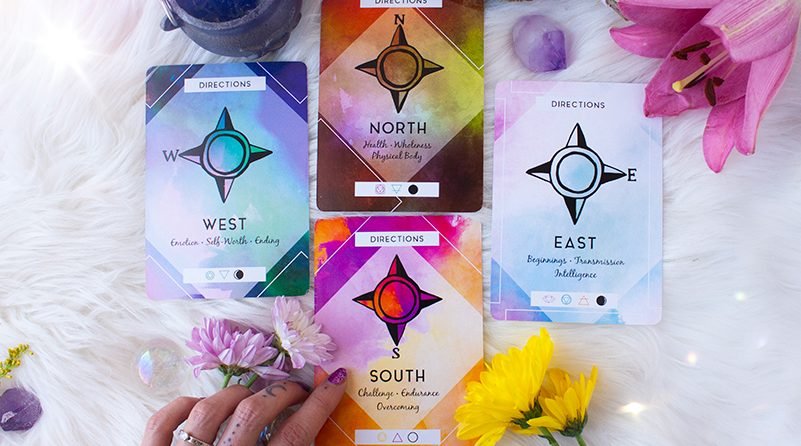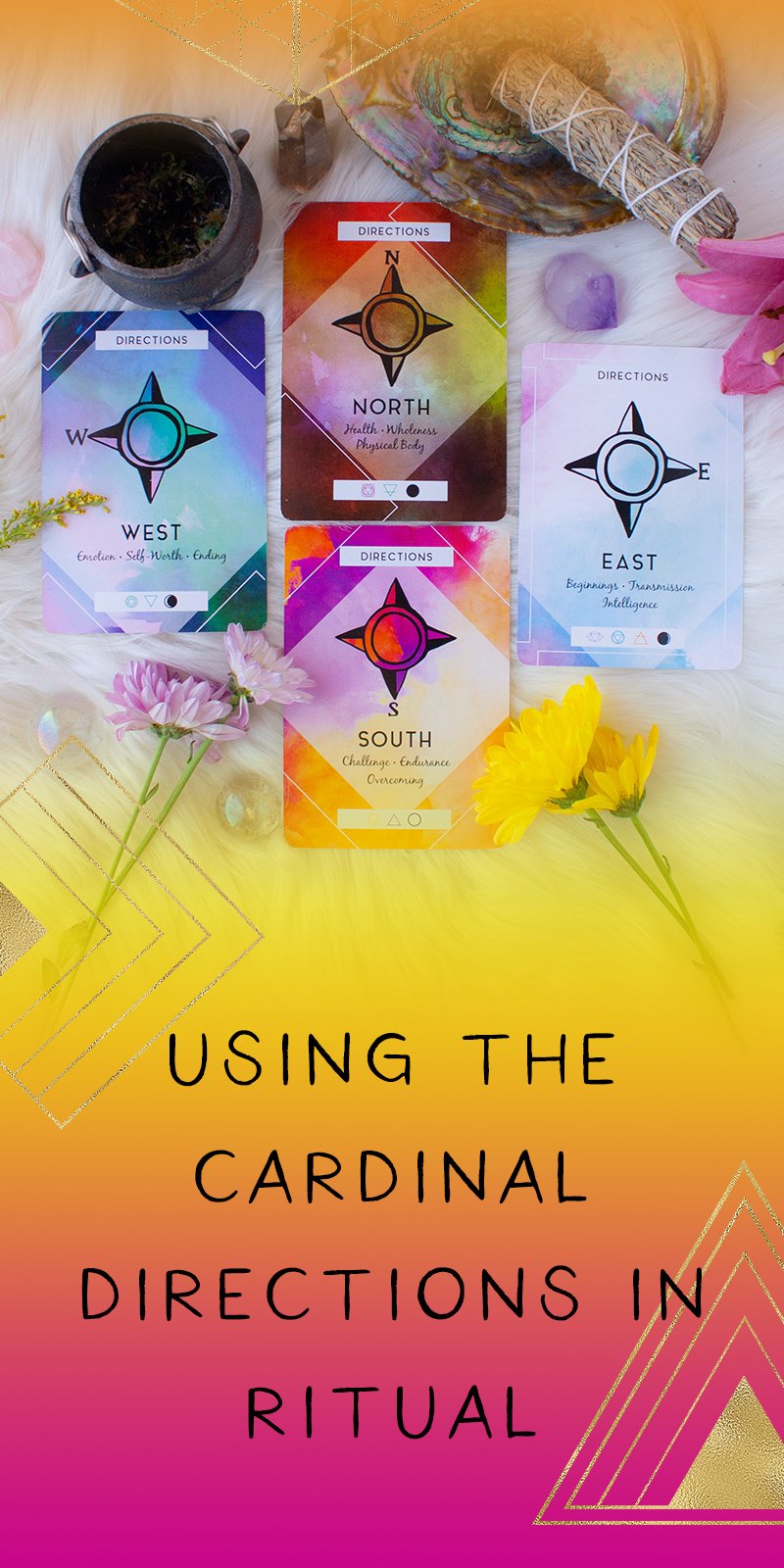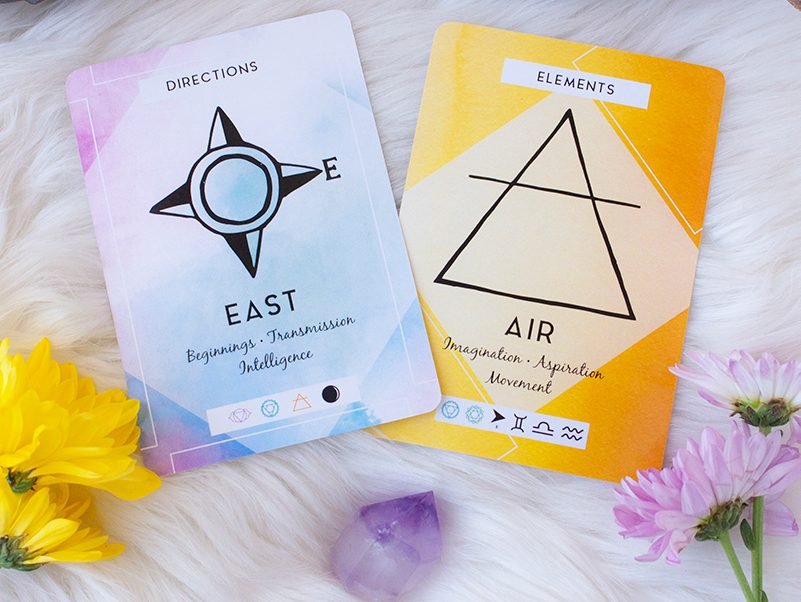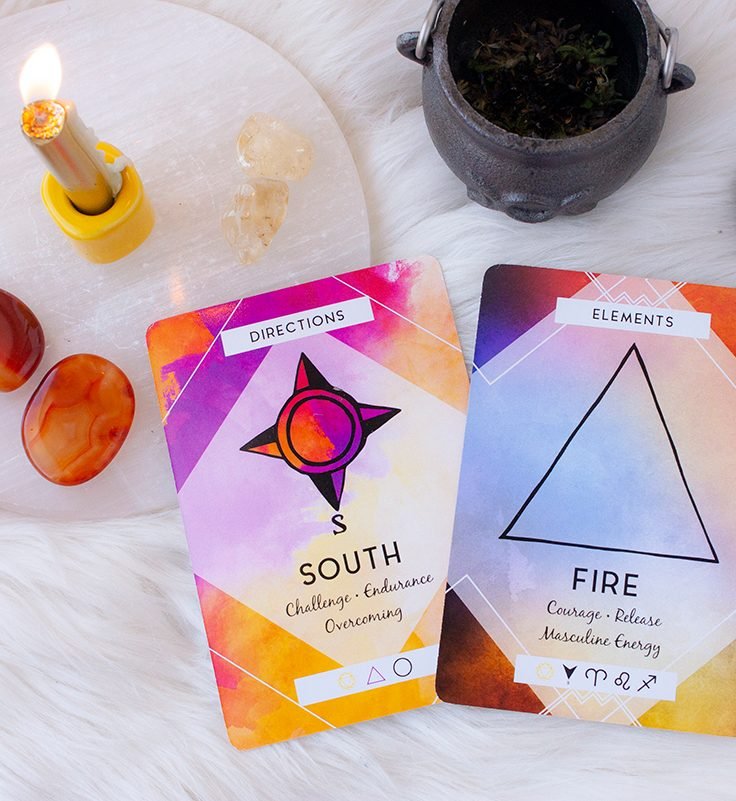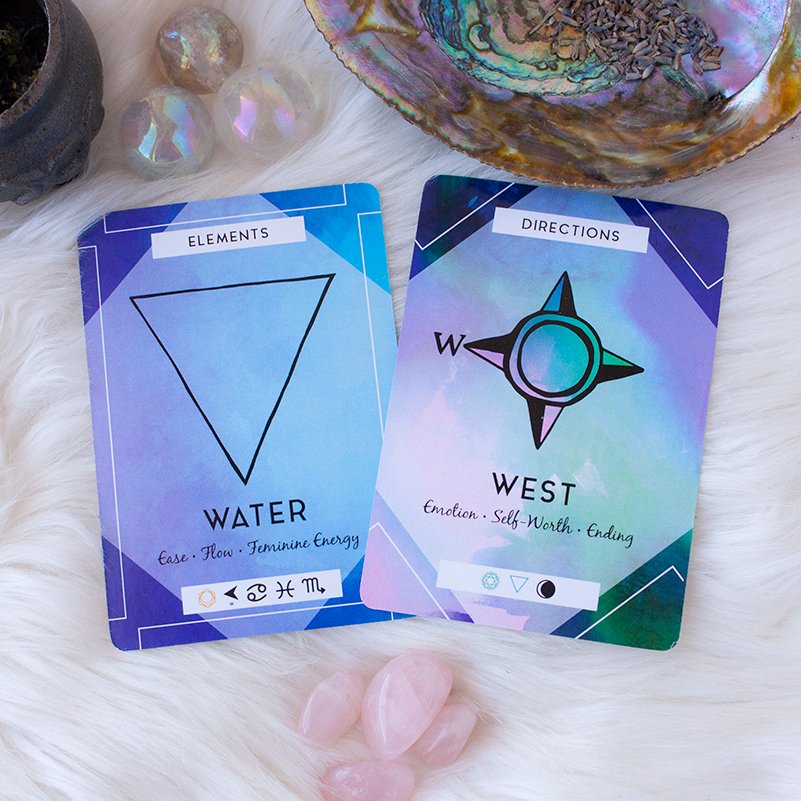Unlocking the Power of your Pineal Gland // 8 Tips
If you're interested in opening your third eye chakra and expanding your psychic abilities, understanding the pineal gland is essential. Ancient cultures were well aware of the power of the pineal gland. It's referenced and depicted in a variety of texts and artwork around the world. Furthermore, a variety of breathing techniques, chants, and exercises from ancient cultures are dedicated to activating this tiny gland inside your brain.
Somewhere in our evolutionary process, we've forgotten about the power of this pea-sized intuitive aid. For many of us, our pineal gland has gone unused and become calcified. Don't worry, there's hope! Science is slowly catching on to this forgotten gland, and there are so many tools (both ancient and modern) to help you activate your mighty pineal gland. Bonus, the tips I'm sharing don't all involve eating copious amounts of seaweed and green leafy vegetables.
In this post, I will cover what the pineal gland is, how it functions in our body physically and energetically, and tips for decalcifying the pineal gland for optimal psychic sight and third eye activation. I’ve linked several studies and resources in this post to help you out along the way! Keep scrolling for a video and more tips.
Science is slowly learning more about the pineal gland. However, many doctors and scientists still dismiss it as a useless gland after sexual maturation. New studies are starting to pique the interest of the scientific community and are shedding light on what many ancient cultures and spiritual communities already know to be true. For starters, did you know that microscopic calcite crystals were recently discovered inside of the pineal gland? I’ll dive into this a bit deeper later in the blog post.
The study of the pineal gland from a scientific and spiritual perspective is deep and complex. I’ve covered as much as I can in this post in a digestible format. However, if you feel called to research further, I encourage you to do so because there is much, both recent and ancient, to be learned about this topic.
What is the Pineal Gland?
The pineal gland is a tiny cone-shaped gland in the center of your brain. It’s about the size of a grain of rice, when not fully utilized but can grow in size when used properly. Its location inside of the brain lines up with the area of the third eye chakra, in the center of the brow bone.
At a quick glance, the pineal gland is responsible for regulating melatonin, circadian rhythms, and spurring sexual maturation. It actually has light receptors in it that function much like an eye, which enables the pineal gland to keep your circadian rhythms in check.
Recent Discoveries About the Pineal Gland
Here’s where things start to get a bit more woo-woo and compelling...
A recent study indicates that DMT, a psychoactive, may be produced in the pineal gland. Though the jury is still out on whether or not DMT is produced in the pineal gland, the implications are intriguing. Many describe the effects of DMT as feeling like an out-of-body experience or a feeling of being connected to all things. Both of these descriptions sound quite similar to being in deep states of meditation.
Another recent study found tiny calcite crystals inside the pineal gland! They are tiny and can only be seen with a microscope. That said, it is one of only two places where natural crystals are found inside the human body, the other being the inner ear. The calcite crystals in your pineal gland are piezoelectric (conduct electricity) when they vibrate. Yes, you read that correctly, there are tiny crystals in your pineal gland that can create energy when they vibrate. Because these crystals are so small, it doesn’t take much to make them vibrate.
Your pineal gland is not protected by the blood-brain barrier and unlike most of your brain and has frequent contact with your blood and cerebrospinal fluid (CSF). In fact, the blood supply to your pineal gland is higher than almost any part of your body! Your cerebrospinal fluid is highly structured water (extremely pure and energized water), which you can learn more about in this wonderful blog post by Jen Isabel Friend here.
These three facts indicate that the pineal gland is an incredibly important point in your brain. The fact that it aligns perfectly with several ancient descriptions of the third eye or spiritual eye is not a coincidence.
Ancient cultures clearly understood the importance of the pineal gland, which is evident by the frequent depictions of third eyes, single eyes, and references to a singular eye in ancient texts. Many ancient pranayama techniques and chants are intended to push your cerebrospinal fluid up to your pineal gland and vibrate the tiny calcite crystals inside. If you’d like to learn more about third eye references in history, I suggest this digital short read by Manly P. Hall.
Based on these few facts, it sounds like we have an energized antennae in our brain. The more important question is, is your pineal antennae working?
Calcification of the Pineal Gland
Now for the downside. It’s estimated that 40% of American’s pineal glands are calcified (this percentage varies from country to country). Calcification of the pineal gland has been seen at ages as young as two! To a certain extent, the calcification of the pineal gland is natural over time, many parts of our body calcify as we age. However, the extent to which our pineal glands are calcifying is likely much greater than what nature intended and certainly makes it harder for us to utilize the full potential of this gland.
Several outside factors can cause the pineal gland to calcify. The top offender is fluoride intake. Most countries add fluoride to their water, with claims of helping tooth decay. Fluoride can aid in cavity prevention, when used topically, but does not appear to add any benefit when ingested and is actually toxic. Read more about this here. Beyond fluoride consumption, processed foods and age also play a role in the calcification of the pineal gland.
Tips for Decalcifying and Activating the Pineal Gland
You can find a host of suggestions online for decalcifying the pineal gland. Many of them may require huge lifestyle changes, which I also share here. I would also like to offer some more realistic suggestions, that, I believe, are just as valuable.
These suggestions work best when they’re combined. Taking a supplement and ignoring the rest of the tips may not yield the results you’re hoping for. Start small and do what you can. I’ve placed the suggestions at the top that I find to be the easiest (and most cost-effective)
.1. Hydrate with High-quality Water
Remember how I said your pineal gland is bathed in cerebrospinal fluid daily? Well, this can’t happen if you’re dehydrated, which most of us are. Try drinking naturally structured spring water or learn techniques for creating your own structured water. Structured water, among other things, does a much better job of hydrating us. Learn more about structured water from my favorite water guru, Jen Isabel Friend, here.
2. Practice Conscious Breathing Techniques
Conscious breathing and pranayama exercises are the simplest and cheapest way to cleanse and activate your pineal gland. Breathing consciously, especially sending the breath deep into your belly, helps push CSF (cerebrospinal fluid) up your spine and up to your brain, bathing your pineal gland in highly charged and clean water.
Three-part breath and the breath of fire are two great options to get started. If you’re not familiar with them, you can find a plethora of videos with instructions with a quick internet search. If you’d like some more advanced suggestions beginning to work with the bandhas (pranic locks) as you practice your breathwork can be helpful. Dr. Joe Dispenza also offers a variety of meditations with breathing designed to push CSF up the spine (I’ve been using the Break the Habit of Being Yourself meditations and enjoying them).
3. Meditate Regularly
Before you run off and say you don’t have time to meditate daily, I want you to know that even ten minutes a day will have a big impact. I also want to emphasize the daily aspect of this step. Regular, consistent meditation will help you access and activate the pineal gland. Learn more about how to start and stick to that meditation practice here. If guided meditations resonate with you, check out my guided meditations here.
4. Add Some Chanting to Your Meditation Practice
Chanting can help vibrate those tiny calcite crystals inside of your pineal gland and wake them up a bit. This is best used once you’ve started the process of decalcifying your pineal gland. Once you’re in a good groove of giving your pineal gland some love, add in some chanting and see if you notice a difference. My favorite meditation to use this “AHHH” meditation by Dr. Wayne Dyer. I always feel AMAZING after completing this meditation!
5. Reduce Fluoride Intake
I’m not saying you have to stop going to your dentist and stop brushing your teeth with fluoridated toothpaste. I am saying to be aware of how much fluoride you’re consuming. Using it topically is one thing, but ingesting it from tap water on a daily basis is something else entirely. Do your research and find out how much fluoride is being added to your local water supply.
Here are a couple of companies that offer great fluoride filtration systems, including fluoride removing straws and water bottles. Check out PWF here for fluoride removing straws and Clearly Filtered here for a variety of fluoride filters, including fluoride removing water bottles. I’ve used PWF’s filters and can attest to their quality. Again, these aren’t sponsored, simply products I’ve used or that look helpful.
6. Eat Mindfully
As I mentioned above, processed foods are another calcifying culprit for the pineal gland. In a fast-paced world, it can be tough to limit all processed foods. I’m just as guilty of relying on easy-to-make processed foods to get me through the day. I invite you to simply become more aware of what you’re putting into your body and how it makes you feel. Opting for whole foods and less processed foods will have a cleansing effect on not only your pineal gland but your entire body.
7. Dark and light
Try minimizing light pollution in your room at night. Your pineal gland controls your circadian rhythm. Consider dimming lights and avoiding screens after sunset, and give yourself time in total darkness before bed. Both of these things will give your pineal gland cues that it’s nighttime and help it maintain normal function.
Alternatively, some ancient practices (that are still practiced today by some) suggest sun-gazing to invigorate your pineal gland and third eye chakra. It’s advised to gaze at the less intense light of the rising or setting sun and not the bright midday sun. Of course, please do your research on this and practice caution. Some also suggest candle gazing as an alternative.
8. Suggested Supplements and Foods
There’s a slew of supplements that can be used to help decalcify the pineal gland. Bonus, they’re also pretty great for your entire body! As with any supplement suggestion, be sure to run it by your healthcare provider and do your research before consuming any supplements.
Here’s a list of supplements to help in combination with the other steps outlined above. Many of these will cause your body to detoxify, please take these with caution and start with just one. I don’t recommend taking all of these at once, as it could leave you feeling pretty awful.
Spirulina
Chlorella
Green leafy vegetables
Turmeric
Apple cider vinegar
Iodine supplements and iodine-rich foods. (Iodine can significantly affect the thyroid. Please, exercise caution and discuss with your healthcare provider before taking iodine supplements.)
There are some great supplement options created by trusted natural herbalists. One product that I’ve been using and enjoy for the purpose of decalcifying my pineal gland is this blend by Anima Mundi Apothecary. This isn’t a sponsored ad, I just really love all of their products!
As I said, doing all of these things at once could be completely overwhelming and unnecessary. Start small and be kind to yourself. Bonus, all of these suggestions are pretty great for your entire body ;)
Want to learn more about the third eye chakra? Check out this previous blog post all about opening the third eye chakra.
Vibrational Healing 101
What sounds are part of your daily life?For many of us, those sounds may be things like cars honking, sirens blaring, alarms and timers beeping, and music on the radio. Those sounds can be incredibly harsh on our nervous systems. Think about it: how do you feel when you hear a horn honking or a siren blaring? Startled, anxious, on edge, heightened, nervous? Most of the sounds we hear on a daily basis aren’t soothing or healing, and many of them are also inevitable. Many of these noises simply go along with living a modern life. But that’s where sound healing comes in as an incredibly helpful tool for resetting the nervous system and realigning our energy centers.Keep scrolling to learn more about some of the science behind sound, the benefits of sound healing, and ways to weave sound healing into your life each day.
What sounds are part of your daily life?
For many of us, those sounds may be things like cars honking, sirens blaring, alarms and timers beeping, and music on the radio.
Those sounds can be incredibly harsh on our nervous systems. Think about it: how do you feel when you hear a horn honking or a siren blaring? Startled, anxious, on edge, heightened, nervous?
Most of the sounds we hear on a daily basis aren’t soothing or healing, and many of them are also inevitable. Many of these noises simply go along with living a modern life. But that’s where sound healing comes in as an incredibly helpful tool for resetting the nervous system and realigning our energy centers.
Keep scrolling to learn more about some of the science behind sound, the benefits of sound healing, and ways to weave sound healing into your life each day.
WHAT IS VIBRATIONAL HEALING?
Vibrational healing, also called, sound healing, frequency healing, or vibrational medicine, uses the vibration of objects that resonate (such as bowls, tuning forks, gongs, and other instruments) as well as the human voice to soothe the body and mind, access a deeper state of meditation, and stimulate healing. Sound healing is definitely having a moment right now, but it’s far from new. Cultures around the world have used sound for healing for centuries.
THE SCIENCE OF SOUND
An article for the New York Times shares this:
“…Healers, sometimes called sounders, argue that sound can have physiological effects because its vibrations are not merely heard but also felt. And vibrations, they say, can lower heart rate variability, relax brain wave patterns and reduce respiratory rates.
When the heart rate is relatively steady, and breathing is deep and slow, stress hormones decrease, said Dr. Mitchell L. Gaynor, an oncologist and clinical assistant professor of medicine at Weill Medical College of Cornell University in New York and the author of "The Healing Power of Sound." That is significant, he said, because stress can depress every aspect of the immune system, "including those that protect us against flu and against cancer.”
A study where participants received about 35 minutes of sound therapy (some in person, and some via an online recording) found that “Statistically significant, highly significant and extremely significant data was produced in the domains of Physical Relaxation, Imagery, Ineffability, Transcendence of Time and Space, Positive Mood, Insightfulness, Disembodiment and Unity across both live and recorded studies.”
There is also some fascinating research being done about the power of sound to help us access alpha brain waves, the brain waves associated with daydreaming, mindfulness, and meditation. Alpha waves, according to studies conducted by neuro-electric therapy engineers Dr. Margaret Patterson and Dr. Ifor Capel, boost the production of serotonin in the body.
There aren’t a ton of studies available, but as you can see research has been done and hopefully will continue to be done to explore the science behind sound healing.
THE BENEFITS OF SOUND HEALING
Some of the benefits of sound healing can include:
Access a deep state of meditation
Relief of physical pain
Lowering stress
Soothe anxiety
Decrease in mood swings
Improved sleep
Improved creativity
Heightened self-awareness
Personally, I find sound healing to be incredibly relaxing and heart-opening. It helps me connect with my intuition, open my heart, and access a deeper meditative state. It definitely helps me release stress and relax as well, letting my body truly restore itself.
HOW TO WEAVE SOUND HEALING INTO YOUR LIFE
Now that you know how amazing sound healing is for you, how can you weave sound healing into your life? Here are a few ways:
Meditate with sound frequency meditations on Spotify - here and here are a few sound healing playlists I like
Buy a singing bowl and play it for yourself
Attend a local sound healing event in your area - often called a sound bath or sound meditation
Listen to binaural beats, music that specifically works to generate alpha waves
Chanting OM
Buy tuning forks and use them at home
Vocal toning to open your chakras (this website shares a simple vocal toning practice)
Have you tried sound healing? If you haven't, I hope you now feel inspired to give it a try!
Everything You Need to Know About Reiki
If you’re reading this blog post, you’ve probably heard of Reiki. Maybe you’ve received a Reiki session, or love Reiki and are thinking about starting a Reiki certification.I’m a Reiki Master, and I often find that even people who have received Reiki before don’t really know much about it. In this blog post, I’ll be explaining what Reiki is, the history of Reiki, the benefits of Reiki, what you might experience with Reiki, and how to weave Reiki into your ritual and spellwork practice.
If you’re reading this blog post, you’ve probably heard of Reiki. Maybe you’ve received a Reiki session, or love Reiki and are thinking about starting a Reiki certification.
I’m a Reiki Master, and I often find that even people who have received Reiki before don’t really know much about it. In this blog post, I’ll be explaining what Reiki is, the history of Reiki, the benefits of Reiki, what you might experience with Reiki, and how to weave Reiki into your ritual and spellwork practice.
WHAT IS ENERGY?
I’d like to start with energy. Reiki is energy healing and energy is a huge buzzword these days — but what is energy?
Everything is energy. This is something science has proven time and time again. Your table, your body, an orange, a tree, sound — our senses don’t detect the energetic movements of things like oranges and tables because they vibrate slowly and at a low frequency, but they’re still made up of energy.
We are all made up of energy. There is only one tiny basic unit that connects everything and makes up all of us.
WHAT IS REIKI?
Now that you know what energy is, what is Reiki? Reiki is a specific kind of energy work. It’s an energy healing modality that was channeled by Dr. Mikao Usui in Japan, which I’ll get into more detail about below.
The word Reiki itself means “Universal Energy.” It’s Universal Energy, spiritual energy, the energy of oneness, that can be channeled from one human being to another to facilitate healing.
Reiki has its own intelligence. You don’t have to be special to give Reiki, which is one of the things I love about it. We all have this energy within us--it simply gets awakened through a process called a Reiki attunement.
Learn more about different types of energy work here.
A BRIEF HISTORY OF REIKI
As I mentioned above, Reiki was channeled by Dr. Mikao Usui. He was born in 1865 in a little village in the mountains of southern Japan into a well-off Buddhist family and was always interested in healing. Later in life, he became a Buddhist monk and lived in a monastery but was still looking for something.
Dr. Usui wanted to find a method of healing that was unattached to any specific religion, accessible to everyone.
So he isolated himself on Mount Kurama fasting, meditating, and praying. After 21 days, he felt an awakening. A vision of light, a feeling of complete peace and oneness, and he saw the ancient symbols that helped him create the Usui Reiki system of healing.
He quickly came down from the mountain and moved back to Tokyo where he established a healing Reiki clinic and school there (around 1922). He wanted to help as many people as possible, so he taught several Reiki Masters, making sure Reiki wouldn’t be forgotten.
Those Reiki Masters trained some other Reiki masters, who further refined the attunement process and the hand positions used. In 1935 one of those Reiki Masters, Dr. Chujiro Hayashi, trained a Japanese American woman who originally came to him for healing, Hawayo Takata.
Hawayo Takata is the person who brought Reiki to the US. She returned home and spread the system of healing to others here, attuning 22 Reiki masters before she died.
BENEFITS OF REIKI
Now that you know a bit about what Reiki is and where it comes from, what are the benefits of Reiki?
I have found over and over again that Reiki will give each individual whatever it is they need. Here is a non-exhaustive list of some of the benefits of Reiki from my experience and from my teachers:
Relief of physical pain and discomfort
Release of limiting belief systems
Release of blocked energy and blocked emotions
Reconnection to your highest self
Reach a calmer, meditative state
Become more present and enjoy your life more
Open to your own self-healing power
Feel lighter and more in balance
Relax and reduce stress
Calm the ego
Connect you to who you really are
Align with your higher calling and purpose
Enhance your connection to spirit
Open your intuitive channel
And more!
WHAT CAN YOU EXPECT IN A REIKI SESSION?
You’ll typically receive a Reiki session laying down on a massage table, and you’ll always be fully clothed. Your practitioner will use a combination of hands-on gentle touch and hands-off (hovering).
Each individual’s experience of Reiki is unique, and there’s definitely no right or wrong way to experience Reiki. You might see color, words, and/or images. You might get intuitive hits, inspiration, and creative ideas. You might have an emotional release like crying afterwards, or the next day. Or maybe you just feel super relaxed. Maybe you fall asleep.
Personally, I often see color and get creative ideas and intuitive hits. I occasionally see images. I typically reach a calmer, more present, meditative state and deeply feel my connection with Source.
HOW TO WEAVE REIKI INTO YOUR RITUAL AND SPELLWORK PRACTICE
Attuned to Reiki? I love weaving Reiki into my ritual and spellwork practice, and you can do it, too! Here are some of my favorite ways to weave Reiki into my witchcraft:
Using Reiki to clear and/or charge my magical tools
Using Reiki in spellwork to charge my spell bag, candle, etc. with my intention
Using Reiki to open my channel to receive messages from my guides and ancestors
There are so many different ways to work with Reiki once you’re attuned. Get creative and follow your intuition!
EXPLORE REIKI FURTHER
Want to learn more about Reiki? Two of my favorite books are The Art of Psychic Reiki by Lisa Campion and This Is Reiki by Frank Arjava Petter.
If you’ve received Reiki before and are thinking about learning Reiki for yourself, check out this article to help you choose a Reiki 1 training that’s a fit for you.
The Four Types of Indigos & How to Thrive as One
An Indigo person is anyone who has the color indigo as the primary color in their auric field. I shared more about the birth of this term and who Indigos are in a previous post. As I shared in the previous post, according to Nancy Tappe, most of us are Indigos now.
An Indigo person is anyone who has the color indigo as the primary color in their auric field. I shared more about the birth of this term and who Indigos are in a previous post. Click here if you missed it and want to learn more about who Indigos are before reading on!
As I shared in the previous post, according to Nancy Tappe, most of us are Indigos now. A more important question to ask is, what kind of Indigo are you? Throughout Nancy’s work with Indigos, she identified four types: humanist, artist, conceptualist, and catalyst. Each Indigo helps progress and connect humanity differently.
Read on to learn more about the different types of Indigos and determine what type of Indigo you are. You may identify strictly with one kind of Indigo personality or a combination of two. I’ve also shared gemstones and activities that will help support each type of Indigo.
Humanist
Humanist Indigos are the social butterflies of the new world. Think Instagrammer’s and YouTubers with huge followings, political mavens, and teachers. Humanists are extremely social beings who feel driven to connect with others. They’re always thinking of new ways to communicate with people, primarily through technology.
Humanist Key Points
Social
Verbal
Relatable
Humanist Purpose
Connect humanity on a larger scale through the use of technology.
Humanist Support
Humanists are often pegged as overactive, due to their social nature. The humanist Indigo will benefit from grounding exercises and stones. If you identify as a humanist and feel off-balance, spend time in nature, meditate on your root chakra, and try carrying grounding stones like hematite, obsidian, and jasper. If you’d like to amplify your humanist traits, focus on your throat chakra, and work with stones like lapis lazuli and sodalite.
Featured card deck: The Ritual Deck
Artist
Indigo artists are, not surprisingly, the artistic powerhouses of the new world. Young people that are seemingly born with the innate ability to sing, dance, and create are the Indigo artists of today. These Inidigos are extremely sensitive and emotional. Unlike previous generations, when emotions were meant to be stuffed and kept quiet, the Indigo artist has no problem expressing their feelings.
Artist Key Points
Expressive
Emotional
Artist Purpose
Create a more expressive and sensitive human race.
Artist Support
Empathic artists Indigos will benefit from learning techniques to protect their energy when they need a break from feeling everything. Working with stones like soothing and protective amethyst or energy shielding labradorite will prove helpful for Indigo artists. If you’d like to amplify your Indigo artist traits meditate on your sacral and throat chakra or work with stones like carnelian and opal.
Conceptualist
Conceptualist Indigos are the systems-oriented engineers and inventors of the new world. These Indigos are introverts and happier behind the scenes observing rather than mingling with their Indigo brothers and sisters. They are the ones inventing new technology and systems enabling humans to connect and communicate on a larger scale.
Conceptualist Key Points
Introverted
Focused
Problem solvers
Conceptualist Purpose
Create better tools and infrastructure to help connect humanity.
Conceptualist Support
Quiet conceptualists can find balance through spending time with people they love and trust. Find likeminded people that you feel comfortable spending time with to get you out of your head from time to time. Working with airy stones like citrine, calcite varieties, or yellow jasper will bring some levity to your world. To hone your problem-solving abilities focus on your solar plexus and sacral chakra.
Featured card deck: The Ritual Deck
Catalyst
Nancy Tappe identified the catalyst group as the smallest group of Indigos. It’s also the group that is least likely to know that they’re Indigos, partly because they’re so detached. Catalyst Indigos are catalysts because they push and force us into new ways of thinking, often without even intending to. These Indigos have a strong sense that they don’t fit in here and can have a difficult time relating to others. Catalysts are often given labels, but it’s their seemingly odd tendencies giving them labels that are forcing us to start doing things differently.
Catalyst Key Points
Detached
Demanding
Feels like they don’t fit in
Catalyst Purpose
Challenge the human race in new ways to inspire change.
Catalyst Support
Similar to conceptualists, catalysts will benefit from spending time with people they love and trust. Because socializing can feel so difficult for the catalyst, they must find people that they genuinely feel comfortable with, even if it’s on rare occasions. Because catalysts are often viewed as offbeat, they will benefit from protective stones like hematite and black tourmaline. Meditating on the throat chakra and working with stones like sodalite and lapis lazuli will help give catalysts a voice when they do need to speak up.
Featured card deck: The Ritual Deck
Featured card deck: The Ritual DeckYou may find different Indigo labels, but these four are based on Nancy Tappe's work. I think they’re a great starting place to understand the Indigo phenomenon better. Crystal children and starseeds are a topic for another day! I believe it’s valuable to start with understanding the purpose and types of the Indigos before diving into these new labels. If you identify as a crystal child, your parents are likely Indigos, and you probably have a lot of Indigo in your aura too.
5 Steps to Access the Akashic Field
Accessing the Akashic field, often referred to as “Akashic records,” can come off as an elite and secretive practice. Maybe you’ve read or heard that you need a specific prayer or guide to access the information held within the Akashic field. Prayer and guides may indeed help, but they’re simply not necessary. Again, I’m not knocking these tools, but I don’t want you to cut yourself off from a spiritual experience because you’ve been told you need something special to access this field of energy.
Accessing the Akashic field, often referred to as “Akashic records,” can come off as an elite and secretive practice. Maybe you’ve read or heard that you need a specific prayer or guide to access the information held within the Akashic field. Prayer and guides may indeed help, but they’re simply not necessary. Again, I’m not knocking these tools, but I don’t want you to cut yourself off from a spiritual experience because you’ve been told you need something special to access this field of energy.If you’re unfamiliar with the term “Akashic field,” it’s the same thing as the Akashic records.
If you’re unfamiliar with both terms or want to learn more about why some prefer the term “field” click here to read a previous post.
Here are my five suggestions for accessing the Akashic field.
Access the Akashic field in 5 steps
These steps are intended to be an ongoing practice. You can practice them all before sitting down to access the Akashic field or do them separately spread out over days. Each step will help you gain access to the Akashic field regardless of when they’re performed.
Raise your vibrational frequency
You’ve probably seen this term used in memes and on t-shirts more than anything else but it’s an important step when trying to access anything in the spirit realm. A slow vibration is closely linked to the physical realm, whereas a higher vibration is linked to spirit. Raising your vibration means you’re operating from a place of love and gratitude which is going to make this work come more naturally. Learn more about raising your vibrational frequency in this guest post from Reiki master, Deborah Arconti.
There are a variety of ways to raise your vibration including meditation, pranayama, some forms of yoga, prayer, mantra work, and creative activities. Keep reading, step two is a powerful tool for raising your vibrational frequency too.
Focus on your crown and soul star chakras
Your soul star chakra, located above the crown chakra, is the gateway to the Akashic field and where many believe your “records” are stored. Your crown chakra, a ball of energy located at the top of your head, must be healthy to access your soul star chakra. Focusing on your crown and soul star chakra are also powerful tools for raising your vibrational frequency. Win, win! Learn more about the crown chakra here and the soul star chakra here. These articles share tips to help you energize both of these chakras. If you feel that your crown chakra is strong and healthy skip ahead to the post about the soul star chakra.
Ask
An overlooked tool in any new practice is to ask for what you want. If you’ve practiced a soul star chakra meditation and are feeling in tune with spirit, the next step is to ask clearly what you’d like to experience from the Akashic field. Here are some suggestions.
What lessons am I here to learn?
Who was I in my most recent past life?
What lessons did I learn from my most recent past life?
What are some traumas I experienced in past lives? (Please, be cautious when asking to experience past life traumas. I recommend experiencing past life traumas with a professional in past life regressions. However, if you feel that this is something you are prepared to handle or need to process, it can be a powerful healing too.)
How can I live this life to my highest potential?
Where are some places I’ve lived in past lives?
What people in my life have I interacted within past lives?
Is __________ the best choice for me in this life?
Trust
You raised your frequency with a meditation, asked to experience a past life, felt a sensation that you were near an ocean, but it didn’t seem like a strong enough sensation so you completely wrote it off. Sound familiar?
In the beginning, it can be easy to question or completely negate your spiritual experiences. Doing deep spiritual work like this is not something that’s often brought up at dinner while growing up. Your natural instinct might be to dismiss your sensations! Maybe you’ve lived two or three decades of being told that the spirit realm doesn’t exist, or that it’s bad to try to access it. If this isn’t your story, that’s great! Trusting your experiences may come naturally to you. Otherwise, be nice to yourself and if you get a sensation, even a faint one, trust it 100%.
Practice
If you don’t feel like much happened the first time you tried accessing the Akashic field, keep at it. The more time you spend raising your vibration and getting comfortable with the sensations you receive from doing this kind of work (which will be experienced differently by everyone) the easier it will be and the more information you’ll receive.
Just like there’s more than one way to meditate, there’s more than one way to access the Akashic field. I encourage you to try these five steps, but if they don’t work for you it doesn’t mean you’re unable to access the Akashic field, you might need to try a different approach and that’s OK.
Using the Cardinal Directions in Ritual
The cardinal directions, North, South, East, and West, can help you with more than navigation. Each direction holds a meaning of its own and corresponds to one of the four elements. There are both simple and complex ways of using the cardinal directions in ritual.A variety of cultures honor the cardinal directions. This article is looking at them from a Pagan and Wiccan perspective. The four directions are often used by Native Americans on the medicine wheel. Neither way is wrong or right, just different, and for different purposes.Read on for meanings and three ways to start using the cardinal directions in your magickal practices.
The cardinal directions, North, South, East, and West, can help you with more than navigation. Each direction holds a meaning of its own and corresponds to one of the four elements. There are both simple and complex ways of using the cardinal directions in ritual.
A variety of cultures honor the cardinal directions. This article is looking at them from a Pagan and Wiccan perspective. The four directions are often used by Native Americans on the medicine wheel. Neither way is wrong or right, just different, and for different purposes.
Read on for meanings and three ways to start using the cardinal directions in your magickal practices.
Connection to the Four Elements
Each direction corresponds to one of the four elements; understanding these connections can help you better understand the energy of each direction.
North corresponds to Earth
East corresponds to Air
South corresponds to Fire
West corresponds to Water
A quick note about these correspondences. The elemental correspondences can vary depending on your location, cultural background, or intuition. Catherine Beyer explains this in her article The Five Element Symbols of Fire, Water, Air, Earth, and Spirit.
The Golden Dawn originated in England, and the directional/elemental correspondences reflect a European perspective. To the south are the warmer climates, and thus is associated with fire. The Atlantic Ocean lies to the west. The north is cold and formidable, a land of the earth but sometimes not a lot else.
If these correspondences don’t feel right to you, that’s ok! For example, if you live in the Southern Hemisphere, you may find that the correspondences feel off. You can reassign the elements in a way that feels natural to you or is in better alignment with your cultural background.
Direction meanings
Here’s a more in-depth look at some meanings and correspondences of each direction.
North
Physical body
Health
Chakra: Root
Element: Earth
Color: Green
South
Hardships
Challenges
Willpower
Chakra: Solar Plexus
Element: Fire
Color: Red
Three ways to use the cardinal directions in ritual
1. Add a layer of meaning to your ritual
The easiest way to start implementing the cardinal directions into your magickal practice is by facing the direction that makes the most sense for what you’re doing. This idea can be applied to oracle and tarot card readings, candle magick, ritual, spellwork, meditation, or working with the moon.
Here are a few examples:
Face North if you’re doing a meditation focused on your health.
Face East if you’re performing a card reading for the new moon because the new moon represents new beginnings.
Face South if you’re asking your guides about how to overcome a problem.
Face West if you’re doing a ritual to help you let go of something.
2. Calling the quarters for protection
The next time you’re practicing a ritual or psychic work start by calling on the four directions, this is also referred to as “calling the quarters.” Calling the quarters will bring you protection and the energy of all of the elements during your practice. It’s also said to create a sacred space that is connected to the spirit realm.
There’s more than one way to call the quarters. A quick google search will offer you a variety of options, but here’s one way:
Imagine each direction as a wind that you’re invoking into your space. You can even imagine a specific Goddess or God for each direction. As you call in each direction, stand facing the direction you’re calling in and ask it to join you for your ritual practice. Many like to start by calling in the North winds first because it will keep your ritual grounded. Rotate in a circle, going through each direction, asking it to join you. When you’re done performing your ritual work, release the winds, and thank them for their assistance and protection.
3. Altar placement
Whether you’re creating a new altar or updating your current altar, the direction it’s facing will have an effect on it. Try to place your altar in a direction that matches the season of life you’re in or want to be in.
Has your altar or sacred space been in the same location for a long time? It might be a time to rearrange and face your altar in a direction that’s in better alignment with your life. Check the meanings for the directions above and note which one feels like where you’re at or want to be right now.
